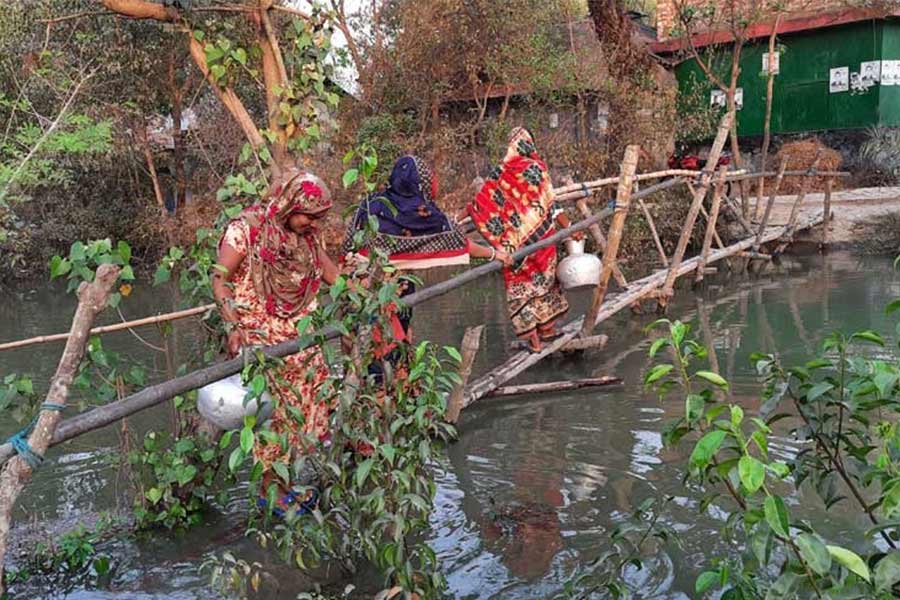
Published :
Updated :

The only easy source of drinking water for the people of Gabura union of Shyamnagar in the coastal Satkhira is a pond called 'Drishtinandan', or spectacular in English. However, saltwater has coursed into it thanks to the impact of Cyclone Remal, sapping the source and leaving several villages in a severe crisis.
It's a situation where there's water everywhere you look, but not a drop to drink.
The crisis highlights a growing concern to communities across Bangladesh, particularly in the Southwest, where extreme weather exacerbated by climate change has emerged as a threat to safe drinking water.
At the end of May, Cyclone Remal wreaked havoc in many districts of the country, including the Sundarbans and adjacent areas. However, the most significant damage in the coastal areas of Satkhira was the salinisation of pond water.
GM Maksudul Alam, chairman of the Gabura Union, said 11 out of 15 villages are facing a severe drinking water crisis.
He said out of 42,000 people in the union, at least 36,000 are facing a drinking water crisis. Women from villages such as Chandanimukha, Dumuria, Kholshibunia, Hetalbunia, Chakbara, Sora and Parshemari have to walk long distances to collect drinking water.
Said-uz Zaman, chairman of Shyamnagar Upazila Parishad, said areas such as Durgabati and Golakhali in Shyamnagar are facing a severe water crisis. The tube wells in the area are not functioning due to the depletion of the freshwater table. People rely mainly on open water bodies for drinking and domestic water, but these have also become unfit for consumption due to the effects of Remal.
According to non-governmental organisations, nearly 700,000 people in the coastal river areas of Satkhira are currently suffering from a lack of drinking water.
A survey conducted by the United Nations Development Programme, or UNDP, in 2021 found that 73 per cent of residents in the Ashashuni and Shyamnagar Upazilas or sub-districts drink unsafe saline water.
Another study by the Bangladesh Soil Resource Institute found that about 53 percent of coastal areas are directly affected by salinity.
Coastal residents of Satkhira, Bagerhat and Khulna have long suffered from a drinking water crisis. Although these areas have water bodies and deep wells, the water remains undrinkable due to geographical factors such as excessive arsenic, salinity, and iron. Residents are constantly struggling to obtain potable water.
Residents of Ashashuni and Shyamnagar say when temperatures rise, their water sources dry up, causing further hardship.
They then look to the sky, hoping for rain.
Good rainfall allows them to collect and store water for a certain period of the year. But heavy rains or storm surges can also cause levees to break or saltwater from shrimp farms to overflow, ruining freshwater sources. Climate change is exacerbating these problems.
In these regions, rainwater is an important source of freshwater. But this year, the lack of rain means they have to rely solely on open water, which is a struggle in itself. People have to walk miles each day with pots from the nearest pond to collect water.
In the midst of these hardships, Remal struck. About 23 kilometres of the Water Development Board's 673-kilometre-long embankments were severely damaged, flooding village after village and destroying sources of drinking water.
Romecha Begum, from Harinagar village, said the crisis was not just about drinking water. There is a severe shortage of water for washing dishes, laundry, bathing and sanitation.
Those who have not faced this crisis cannot understand the suffering of the common people of the south coast," she added.
Shefali Begum of Datinakhali village said that during the Remal, the storm and heavy rains flooded the ponds. Salty and unhealthy water from these ponds is used for cooking and bathing, which causes diseases.


 For all latest news, follow The Financial Express Google News channel.
For all latest news, follow The Financial Express Google News channel.